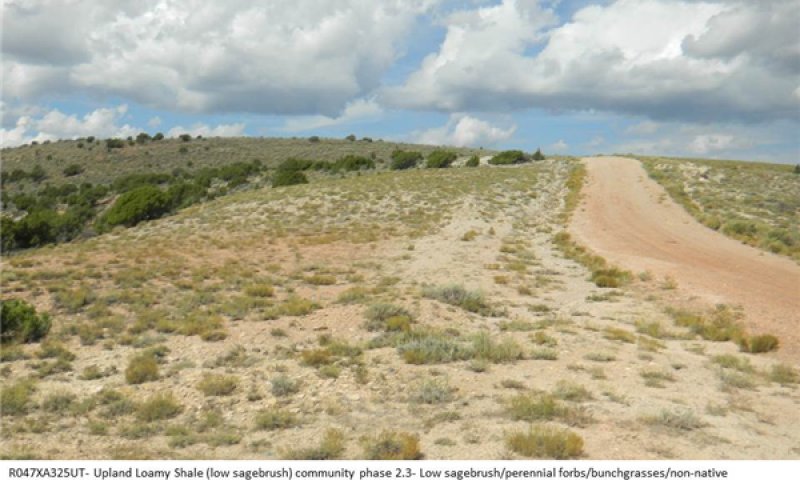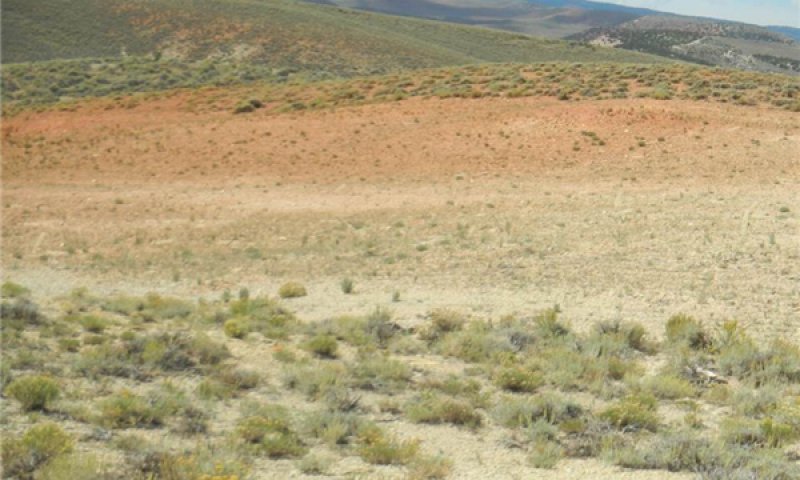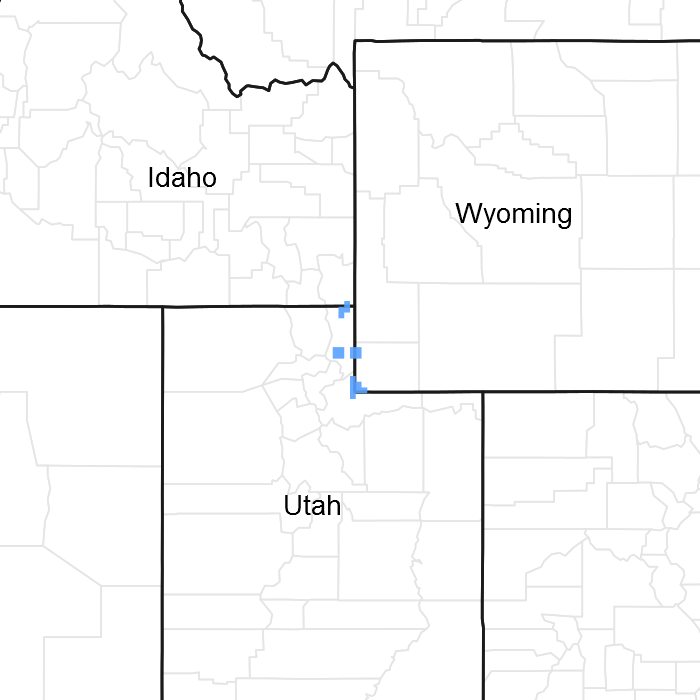Ecological dynamics
It is impossible to determine in any quantitative detail the Historic Climax Plant Community (HCPC) for this ecological site because of the lack of direct historical documentation preceding all human influence. In some areas, the earliest reports of dominant plants include the cadastral survey conducted by the General Land Office, which began in the late 19th century for this area (Galatowitsch 1990). However, up to the 1870s the Shoshone Indians, prevalent in northern Utah and neighboring states, grazed horses and set fires to alter the vegetation for their needs (Parson 1996). In the 1860s, Europeans brought cattle and horses to the area, grazing large numbers of them on unfenced parcels year-long (Parson 1996). Itinerant and local sheep flocks followed, largely replacing cattle as the browse component increased.
Below is a State and Transition Model diagram to illustrate the “phases” (common plant communities), and “states” (aggregations of those plant communities) that can occur on the site. Differences between phases and states depend primarily upon observations of a range of disturbance histories in areas where this ESD is represented. These situations include grazing gradients to water sources, fence-line contrasts, patches with differing dates of fire, herbicide treatment, tillage, etc. Reference State 1 illustrates the common plant communities that probably existed just prior to European settlement.
The major successional pathways within states, (“community pathways”) are indicated by arrows between phases. “Transitions” are indicated by arrows between states. The drivers of these changes are indicated in codes decipherable by referring to the legend at the bottom of the page and by reading the detailed narratives that follow the diagram. The transition between Reference State 1 and State 2 is considered irreversible because of the naturalization of exotic species of both flora and fauna, possible extinction of native species, and climate change. There may have also been accelerated soil erosion.
When available, monitoring data (of various types) were employed to validate more subjective inferences made in this diagram. See the complete files in the office of the State Range Conservationist for more details.
The plant communities shown in this State and Transition Model may not represent every possibility, but are probably the most prevalent and recurring plant communities. As more monitoring data are collected, some phases or states may be revised, removed, and/or new ones may be added. None of these plant communities should necessarily be thought of as “Desired Plant Communities.” According to the USDA NRCS National Range & Pasture Handbook (USDA-NRCS 2003), Desired Plant Communities (DPC’s) will be determined by the decision-makers and will meet minimum quality criteria established by the NRCS. The main purpose for including descriptions of a plant community is to capture the current knowledge at the time of this revision.
State 1
Reference State
The Reference State is a description of this ecological site prior to Euro-American settlement but long after the arrival of Native Americans. The description of the Reference State was determined by NRCS Soil Survey Type Site Location information and familiarity with rangeland relict areas where they exist. The least modified plant community (1.1) within the Reference State would have been a low sagebrush (Artemisia arbuscula spp. arbuscula) -dominated shrubland with sparse bunchgrasses and native perennial forbs. The understory of the reference plant community (1.1) would have been dense enough to carry wildfire only rarely (Steinberg 2002). Low sagebrush typically only occurs after wet years or on more mesic sites (Steinberg 2002). Following natural wildfire events (1.1a) the reference plant community would have shifted towards one dominated by mixed grasses (1.2). Low sagebrush would have been much reduced and yellow rabbitbrush (Chrysothamnus viscidiflorus) would have increased. In the absence of fire (1.2a) and with a viable shrub seed source, low sagebrush would have increased, and the site would have slowly returned to the reference plant community. Heavy grazing (1.1b) would have created a dominance of low sagebrush with a much reduced understory (1.3). A fire occurring in 1.3 could cause the community to shift back to 1.2 (1.3a), this would have allowed the bunchgrasses and perennial forbs to re-establish, which could then shift the plant community back towards the reference plant community (1.1) from 1.2. A more complete list of species by lifeform for the Reference State is available in the accompanying tables in the “Plant Community Composition by Weight and Percentage” section of this document.
Community 1.1
Low sagebrush/bunch grasses/perennial forbs
The least modified plant community in the Reference State would have been a low sagebrush-dominated site with scattered bunchgrasses including bluebunch wheatgrass (Pseudoroegneria spicata), Indian ricegrass (Achnatherum hymenoides), Sandberg bluegrass (Poa secunda), and muttongrass (Poa fendleriana). Native perennial forbs would have been present as well.
Table 5. Annual production by plant type
| Plant type |
Low
(lb/acre) |
Representative value
(lb/acre) |
High
(lb/acre) |
| Shrub/Vine |
248 |
338 |
428 |
| Grass/Grasslike |
220 |
300 |
380 |
| Forb |
83 |
113 |
143 |
| Total |
551 |
751 |
951 |
Table 6. Ground cover
| Tree foliar cover |
0%
|
| Shrub/vine/liana foliar cover |
39-41%
|
| Grass/grasslike foliar cover |
14-16%
|
| Forb foliar cover |
4-6%
|
| Non-vascular plants |
0%
|
| Biological crusts |
0%
|
| Litter |
0%
|
| Surface fragments >0.25" and <=3" |
0%
|
| Surface fragments >3" |
0%
|
| Bedrock |
0%
|
| Water |
0%
|
| Bare ground |
0%
|
Table 7. Canopy structure (% cover)
| Height Above Ground (ft) |
Tree |
Shrub/Vine |
Grass/
Grasslike |
Forb |
| <0.5 |
– |
– |
– |
– |
| >0.5 <= 1 |
– |
– |
– |
4-6% |
| >1 <= 2 |
– |
39-41% |
14-16% |
– |
| >2 <= 4.5 |
– |
– |
– |
– |
| >4.5 <= 13 |
– |
– |
– |
– |
| >13 <= 40 |
– |
– |
– |
– |
| >40 <= 80 |
– |
– |
– |
– |
| >80 <= 120 |
– |
– |
– |
– |
| >120 |
– |
– |
– |
– |
Community 1.2
Bunchgrasses/perennial forbs
This plant community would have developed following the removal of low sagebrush by a wildfire event allowing yellow rabbitbrush to temporarily increase. The fire-resistant bunchgrasses remaining in this plant community would have included bluebunch wheatgrass, Indian ricegrass, Sandberg bluegrass, and muttongrass.
Community 1.3
Low sagebrush/perennial forbs/bunchgrasses
This plant community would have developed following heavy localized grazing by Native American horses, elk, or bison. Utilization would have been mainly on grasses, creating a near monoculture of low sagebrush.
Pathway 1.1a
Community 1.1 to 1.2
Wildfire would have temporarily reduced or removed low sagebrush, shifting the Reference State towards a mixed grass-dominated site.
Pathway 1.1b
Community 1.1 to 1.3
Heavy continuous season-long grazing by elk will convert the plant community to a low sagebrush community with a substantially reduced bunchgrass component.
Pathway 1.2a
Community 1.2 to 1.1
Eventually low sagebrush would have re-established in the plant community, and the species composition would have shifted towards the Reference Plant Community (1.1) in the absence of fire.
Pathway 1.3a
Community 1.3 to 1.2
The perennial bunchgrasses would have recovered and increased after a substantial reduction in herbivory by grazers.
State 2
Low Sagebrush/ Introduced Non-natives State
State 2 is very similar to State 1 in form and function, with the exception of the presence of non-native plants and animals, possible extinctions of native species, and a different climate. The fire return interval is also altered in State 2. Although fires occur rarely, the ecological sites typically found in association with this site may have longer fire return intervals, allowing Utah juniper to establish within these sites. The juniper is then able to establish within the low sagebrush site (2.3). Utah juniper is found in this state, but is not dominant. State 2 is a description of the ecological site shortly following Euro-American settlement. This State can be regarded as the current potential. This site is typically found with few invasive species. It takes excessive disturbance to move this this site from State 2. This is probably due to the soil characteristics of the site which include high rock content to shallow bedrock. There is not much soil for plants to occupy in this site. Those that do well in this site are typically low growing forbs and bunch grasses. These appear to occupy the soil, making it more difficult for non-native or invasive species to establish.
Community 2.1
Low sagebrush/bunchgrasses/forbs/non-native species
This plant community is characterized by low sagebrush dominance with scattered bunchgrasses including bluebunch wheatgrass, Indian ricegrass, Sandberg bluegrass, and muttongrass. A few native perennial forbs are also present. The community has some non-native species present, but they do not dominant or control the site.
Community 2.2
Bunchgrasses/perennial forbs/non-native species
This plant community develops following the removal of low sagebrush by a wildfire event, allowing yellow rabbitbrush to temporarily increase. The fire-resistant bunchgrasses that will remain in this plant community include bluebunch wheatgrass, Indian ricegrass, Sandberg bluegrass, and muttongrass. This community also contains some non-native species but they are not dominant and do not control site dynamics.
Community 2.3
Low sagebrush/perennial forbs/bunchgrasses/non-native species/Utah juniper

Figure 4. Community Phase 2.3

Figure 5. Ground cover community phase 2.3
This plant community develops following heavy localized grazing by elk, horses, and cattle. Utilization mainly on grasses creates the near monoculture of low sagebrush. There may be a few non-native species present, but they do not dominant the site. Utah juniper may also be within the site. This typically occurs when the associated sagebrush sites adjacent to the low sagebrush site begin to have juniper creep into the site. This increases the likelihood of juniper coming into the low sagebrush site.
Pathway 2.1a
Community 2.1 to 2.2
Wildfire will temporarily reduce or remove low sagebrush, shifting the plant community towards a mixed grass dominated site.
Pathway 2.1b
Community 2.1 to 2.3
Heavy continuous season-long grazing by elk, horses, and cattle will convert the plant community to a low sagebrush community with a substantially reduced bunchgrass component. Also, increasing the fire return interval will allow low sagebrush to increase while decreasing the understory component.
Pathway 2.2a
Community 2.2 to 2.1
Eventually low sagebrush will re-establish in the plant community, and the species composition will shift towards Community Phase 2.1 in the absence of fire.
Pathway 2.3a
Community 2.3 to 2.2
Fire in this community will reduce or temporarily remove the sagebrush.
State 3
Introduced Annuals/ Biennials State
Certain invasive annuals and biennial forbs such as cheatgrass, Russian thistle, and halogeton are favored by soil disturbance.
Although there have been some previous attempts to apply tillage and chemicals to improve the composition and productivity at some locations within this ESD (see files in the State Range Conservationist Office for details), the responses are too minor to justify the financial investment. Therefore, currently available manipulations are not recommended.
Community 3.1
Introduced Annuals

Figure 6. Community phase 3.1
Cheatgrasses, Russian thistle and halogeton typcially dominate this community phase. This is typically found next to disturbances such as roads or powerline right of ways.
State 4
Cushion Plants/Eroded State
This is a distrophicated (lacking nutrients) State characterized by a truncated soil profile and impoverished vegetation. Soil organic matter and nutrient stores have been lost due to excessive soil erosion. Only those plants resistant to mechanical impacts and nutrient-depleted soils remain.
As with State 3, although there have been some previous attempts to apply tillage and chemicals to improve the composition and productivity at some locations within this ESD (see files in the State Range Conservationist Office for details), the responses are too minor to justify the financial investment. Therefore, currently available manipulations are not recommended.
Community 4.1
Cushion Plants
The plant community is characterized by the few species such as cushion plants (e.g. Phlox spp., Leptodactylon spp., Antennaria spp. and Stenotus spp) which are resistant to severe ground disturbance and soil erosion.
Transition T1a
State 1 to 2
The simultaneous introduction of exotic species, both plants and animals, along with climate change, caused State 1 to transition to State 2. Reversal of such historic changes (i.e. a return pathway) back to State 1 is not practical.
Transition T2a
State 2 to 3
The Low Sagebrush/ Introduced Non-natives State will transition to the Cushion Plants/Eroded State following severe ground disturbance/mechanical damage caused by excessive foot or wheel traffic, followed by accelerated soil erosion. The approach to this transition is indicated by an increase in exposed bare soil and evidence of soil erosion (i.e. pedestalling of plants and/or surface rock, rilling). This transition is triggered by severe ground disturbance.
Transition T2b
State 2 to 4
The Low Sagebrush/ Introduced Non-natives State will transition to the Cushion Plants/Eroded State following severe ground disturbance/mechanical damage caused by excessive foot or wheel traffic, followed by accelerated soil erosion. The approach to this transition is indicated by an increase in exposed bare soil and evidence of soil erosion (i.e. pedestalling of plants and/or surface rock, rilling). This transition is triggered by severe ground disturbance.
Transition T3a
State 3 to 4
The Introduced Annuals/Biennials State will transition to the Cushion Plants/Eroded State when the site is exposed to increased soil erosion. The approach to this transition is indicated by an increase in exposed bare soil and evidence of soil erosion (i.e. pedestalling of plants and/or surface rock, rilling) and an increase in species capable of tolerating severe ground disturbance and erosion such as curlytop gumweed (Grindelia squarrosa) and cushion plants (e.g. Phlox spp., Leptodactylon spp., Stenotus acaulis). The transition is triggered by accelerated soil erosion.
Although there have been some previous attempts to apply tillage and chemicals to improve the composition and productivity at some locations within this ESD (see files in the State Range Conservationist Office for details), the responses are too minor to justify the financial investment. Therefore, currently available manipulations are not recommended.






